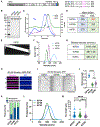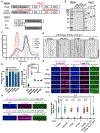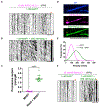Synergistic autoinhibition and activation mechanisms control kinesin-1 motor activity
- PMID: 35649356
- PMCID: PMC9365671
- DOI: 10.1016/j.celrep.2022.110900
Synergistic autoinhibition and activation mechanisms control kinesin-1 motor activity
Erratum in
-
Synergistic autoinhibition and activation mechanisms control kinesin-1 motor activity.Cell Rep. 2022 Jun 28;39(13):111016. doi: 10.1016/j.celrep.2022.111016. Cell Rep. 2022. PMID: 35767955 Free PMC article. No abstract available.
Abstract
Kinesin-1 activity is regulated by autoinhibition. Intramolecular interactions within the kinesin heavy chain (KHC) are proposed to be one facet of motor regulation. The KHC also binds to the kinesin light chain (KLC), which has been implicated in both autoinhibition and activation of the motor. We show that the KLC inhibits the kinesin-microtubule interaction independently from the proposed intramolecular interaction within KHC. Cargo-adaptor proteins that bind the KLC stimulated processive movement, but the landing rate of activated kinesin complexes remained low. Mitogen-activated protein 7 (MAP7) enhanced motility by increasing the landing rate and run length of the activated kinesin motors. Our results support a model whereby the motor activity of the kinesin is regulated by synergistic inhibition mechanisms and that cargo-adaptor binding to the KLC releases both mechanisms. However, a non-motor MAP is required for robust microtubule association of the activated motor. Thus, human kinesin is regulated by synergistic autoinhibition and activation mechanisms.
Keywords: CP: Molecular biology; dynein; kinesin; microtubule; motor protein.
Copyright © 2022 The Author(s). Published by Elsevier Inc. All rights reserved.
Conflict of interest statement
Declaration of interests The authors declare no competing interests.
Figures





Similar articles
-
JIP3 Activates Kinesin-1 Motility to Promote Axon Elongation.J Biol Chem. 2015 Jun 19;290(25):15512-15525. doi: 10.1074/jbc.M115.651885. Epub 2015 May 5. J Biol Chem. 2015. PMID: 25944905 Free PMC article.
-
BicD and MAP7 Collaborate to Activate Homodimeric Drosophila Kinesin-1 by Complementary Mechanisms.Traffic. 2025 Apr-Jun;26(4-6):e70008. doi: 10.1111/tra.70008. Traffic. 2025. PMID: 40384341 Free PMC article.
-
The auto-inhibitory domain and ATP-independent microtubule-binding region of Kinesin heavy chain are major functional domains for transport in the Drosophila germline.Development. 2014 Jan;141(1):176-86. doi: 10.1242/dev.097592. Epub 2013 Nov 20. Development. 2014. PMID: 24257625 Free PMC article.
-
Kinesin carries the signal.Trends Biochem Sci. 2001 Sep;26(9):545-50. doi: 10.1016/s0968-0004(01)01931-4. Trends Biochem Sci. 2001. PMID: 11551791 Review.
-
Traffic control: regulation of kinesin motors.Nat Rev Mol Cell Biol. 2009 Nov;10(11):765-77. doi: 10.1038/nrm2782. Nat Rev Mol Cell Biol. 2009. PMID: 19851335 Review.
Cited by
-
Kinesin-1 transports morphologically distinct intracellular virions during vaccinia infection.J Cell Sci. 2023 Mar 1;136(5):jcs260175. doi: 10.1242/jcs.260175. Epub 2022 Sep 30. J Cell Sci. 2023. PMID: 36093836 Free PMC article.
-
Autoinhibited kinesin-1 adopts a hierarchical folding pattern.Elife. 2023 Nov 1;12:RP86776. doi: 10.7554/eLife.86776. Elife. 2023. PMID: 37910016 Free PMC article.
-
Stick-slip motion and universal statistics of cargo transport within living cells.bioRxiv [Preprint]. 2025 May 23:2025.05.19.654995. doi: 10.1101/2025.05.19.654995. bioRxiv. 2025. PMID: 40475663 Free PMC article. Preprint.
-
A Nesprin-4/kinesin-1 cargo model for nuclear positioning in cochlear outer hair cells.Front Cell Dev Biol. 2022 Sep 23;10:974168. doi: 10.3389/fcell.2022.974168. eCollection 2022. Front Cell Dev Biol. 2022. PMID: 36211453 Free PMC article.
-
ALS-linked KIF5A ΔExon27 mutant causes neuronal toxicity through gain-of-function.EMBO Rep. 2022 Aug 3;23(8):e54234. doi: 10.15252/embr.202154234. Epub 2022 Jun 23. EMBO Rep. 2022. PMID: 35735139 Free PMC article.
References
-
- Crimella C, Baschirotto C, Arnoldi A, Tonelli A, Tenderini E, Airoldi G, Martinuzzi A, Trabacca A, Losito L, Scarlato M, et al. (2012). Mutations in the motor and stalk domains of KIF5A in spastic paraplegia type 10 and in axonal Charcot-Marie-Tooth type 2. Clin. Genet 82, 157–164. 10.1111/j.1399-0004.2011.01717.x. - DOI - PubMed
Publication types
MeSH terms
Substances
Grants and funding
LinkOut - more resources
Full Text Sources
Miscellaneous

